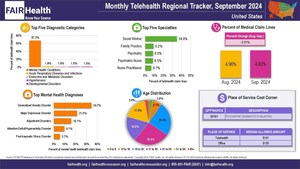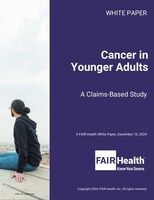Lyme Disease Diagnoses Increased 357 Percent in Rural Areas over Past 15 Years, according to Private Insurance Claims
From 2007 to 2021, Claims with Lyme Disease Diagnoses Rose 65 Percent in Urban Areas, according to FAIR Health Study
NEW YORK, Aug. 2, 2022 /PRNewswire/ -- Lyme disease has experienced notable growth in the United States over the past 15 years and, as a result, has become an illness of increasing national concern. From 2007 to 2021, private insurance claim lines with Lyme disease diagnoses rose 357 percent in rural areas and 65 percent in urban areas. These and other findings on this tick-borne, bacterial illness were captured in an infographic just released by FAIR Health. The national, independent organization used its database of over 36 billion privately billed healthcare claims to conduct its 15-year analysis of Lyme disease; this analysis builds upon a previous FAIR Health infographic that studied 10 years of Lyme disease data. Click here for the infographic released today.
Rural and Urban Differences
The infographic reveals key differences in prevalence of Lyme disease when comparing rural and urban areas. From 2016 to 2021, claim lines with Lyme disease diagnoses increased 60 percent in rural areas and 19 percent in urban areas, with diagnoses peaking nationally in June and July of each year. During these summer months, rural areas, on average, had a greater share of claim lines associated with Lyme disease diagnoses than urban areas. From November to April, however, claim lines with Lyme disease diagnoses occurred more often in urban than rural areas.
Geographic Distribution
In 2017, the states with the greatest proportion of claim lines with Lyme disease diagnoses as a percentage of all diagnoses in the state, from highest to lowest, were New Jersey, Connecticut, North Carolina, Rhode Island and Vermont. Given that Lyme disease has been historically associated with the Northeast and upper Midwest, the status of North Carolina as the state with the third highest percentage of Lyme disease claim lines in 2017 suggested marked expansion to a new region. By 2021, however, North Carolina had dropped from the list.
The top states in 2021, from highest to lowest, were New Jersey, Vermont, Maine, Rhode Island and Connecticut. Maine, which was not previously on the list of top five states for Lyme disease claim lines, assumed third place in 2021, suggesting a growing presence of the tick-borne illness in the state. Connecticut and Vermont switched places, with Vermont emerging as number two and Connecticut dropping to number five.
Later Diagnoses
Although Lyme disease is treatable with antibiotics, some Lyme patients later develop conditions with long-term symptoms, such as fatigue, muscle and joint pain and cognitive issues. Such conditions have been linked to post-treatment Lyme disease syndrome, sometimes called chronic Lyme disease.
To identify later diagnoses associated with Lyme disease, FAIR Health examined a statistically significant cohort of individuals in its private insurance claims database from 2017 to 2021, comparing the prevalence of certain diagnoses among Lyme patients to all patients in the cohort. The analysis found that diagnoses such as malaise and fatigue and soft-tissue-related issues were more common among Lyme patients than among the total patient population. Across all age groups, patients with Lyme disease were generally more likely to have these apparently associated diagnoses than all patients in the cohort.
FAIR Health President Robin Gelburd stated, "Lyme disease remains a growing public health concern. FAIR Health will continue to use its repository of claims data to provide actionable and relevant insights to healthcare stakeholders seeking to better understand the ongoing rise of Lyme disease cases."
This is the third study FAIR Health has conducted on Lyme disease, the first appearing in an infographic released in 2017 and the second in a white paper published in 2019.
For the new infographic, click here.
Follow us on Twitter @FAIRHealth
About FAIR Health
FAIR Health is a national, independent nonprofit organization that qualifies as a public charity under section 501(c)(3) of the federal tax code. It is dedicated to bringing transparency to healthcare costs and health insurance information through data products, consumer resources and health systems research support. FAIR Health possesses the nation's largest collection of private healthcare claims data, which includes over 36 billion claim records and is growing at a rate of over 2 billion claim records a year. FAIR Health licenses its privately billed data and data products—including benchmark modules, data visualizations, custom analytics and market indices—to commercial insurers and self-insurers, employers, providers, hospitals and healthcare systems, government agencies, researchers and others. Certified by the Centers for Medicare & Medicaid Services (CMS) as a national Qualified Entity, FAIR Health also receives data representing the experience of all individuals enrolled in traditional Medicare Parts A, B and D; FAIR Health includes among the private claims data in its database, data on Medicare Advantage enrollees. FAIR Health can produce insightful analytic reports and data products based on combined Medicare and commercial claims data for government, providers, payors and other authorized users. FAIR Health's systems for processing and storing protected health information have earned HITRUST CSF certification and achieved AICPA SOC 2 compliance by meeting the rigorous data security requirements of these standards. As a testament to the reliability and objectivity of FAIR Health data, the data have been incorporated in statutes and regulations around the country and designated as the official, neutral data source for a variety of state health programs, including workers' compensation and personal injury protection (PIP) programs. FAIR Health data serve as an official reference point in support of certain state balance billing laws that protect consumers against bills for surprise out-of-network and emergency services. FAIR Health also uses its database to power a free consumer website available in English and Spanish, which enables consumers to estimate and plan for their healthcare expenditures and offers a rich educational platform on health insurance. An English/Spanish mobile app offers the same educational platform in a concise format and links to the cost estimation tools. The website has been honored by the White House Summit on Smart Disclosure, the Agency for Healthcare Research and Quality (AHRQ), URAC, the eHealthcare Leadership Awards, appPicker, Employee Benefit News and Kiplinger's Personal Finance. FAIR Health also is named a top resource for patients in Dr. Marty Makary's book The Price We Pay: What Broke American Health Care—and How to Fix It and Dr. Elisabeth Rosenthal's book An American Sickness: How Healthcare Became Big Business and How You Can Take It Back. For more information on FAIR Health, visit fairhealth.org.
Contact:
Rachel Kent
Senior Director of Marketing
FAIR Health
646-396-0795
[email protected]
SOURCE FAIR Health

WANT YOUR COMPANY'S NEWS FEATURED ON PRNEWSWIRE.COM?
Newsrooms &
Influencers
Digital Media
Outlets
Journalists
Opted In






Share this article